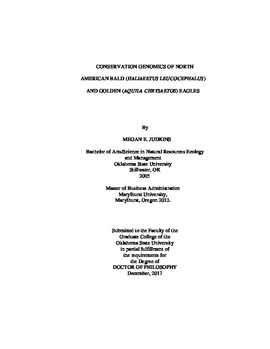| dc.contributor.advisor | Van Den Bussche, Ronald A. | |
| dc.contributor.author | Judkins, Megan E. | |
| dc.date.accessioned | 2018-06-18T16:02:20Z | |
| dc.date.available | 2018-06-18T16:02:20Z | |
| dc.date.issued | 2017-12 | |
| dc.identifier.uri | https://hdl.handle.net/11244/300060 | |
| dc.description.abstract | Although eagles play pivotal roles in most Native Americans, First Nations, and Mesoamericans cultures and represent many countries around the world as the national symbol, these ecologically important predators still face many anthropogenic stressors. Stressors currently affecting bald and golden eagle populations include electrocution, habitat loss and degradation, lead poisoning, wind turbines, and disturbances. Despite the number of stressors these species face, neither of these species have been thoroughly studied from a genetic standpoint causing concern about the long-term conservation of these ecologically and culturally important species. To begin addressing the lack of genetic information about these species, each chapter addressed critical information that is lacking for both species. In Chapter 1, the Holarctic phylogeographic patterns, genetic variation, and demographic history of golden eagles in North America were assessed. The results indicated that there are two genetic lineages of golden eagles with only one Holarctic haplotype, there is little to no modern day gene flow between Nearctic and Palearctic golden eagles, and that the current distribution of haplotypes in the Nearctic reveal a recent population expansion with moderate levels of gene flow. For Chapter 2 and 3, a custom 100K SNP array was designed and subsequently used to assess the levels of the partitioning of genetic variation, SNPs under putative selection, and to begin the development of biologically sound management units. The results of both of the chapters revealed significant levels of genetic structure within the population and a list of putative SNPs under selection was developed. Finally, in Chapter 4, a population of bald eagles in New Jersey was evaluated to determine the nest turnover rate and relatedness of hatchling individuals in the population. Results show the population has high rates of inbreeding, moderate levels of nest turnover rates, and the presence of half sibling and unrelated relationships between individuals raised in the same nest in the same year. The findings of my research provide a new baseline of data for the conservation of bald and golden eagles. This information will be critical in the development of conservation management plans. | |
| dc.format | application/pdf | |
| dc.language | en_US | |
| dc.rights | Copyright is held by the author who has granted the Oklahoma State University Library the non-exclusive right to share this material in its institutional repository. Contact Digital Library Services at lib-dls@okstate.edu or 405-744-9161 for the permission policy on the use, reproduction or distribution of this material. | |
| dc.title | Conservation genomics of North American bald (Haliaeetus leucocephalus) and golden (Aquila chrysaetos) eagles | |
| dc.contributor.committeeMember | Hamilton, Meredith Jean | |
| dc.contributor.committeeMember | Lish, Jim | |
| dc.contributor.committeeMember | Doust, Andrew | |
| osu.filename | Judkins_okstate_0664D_15473.pdf | |
| osu.accesstype | Open Access | |
| dc.type.genre | Dissertation | |
| dc.type.material | Text | |
| thesis.degree.discipline | Zoology | |
| thesis.degree.grantor | Oklahoma State University | |
